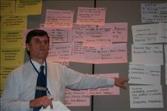On Tuesday 24th January 1961 disaster struck Dwellingup, a Forestry Department stronghold, deep in the jarrah forests 110kms south of Perth.
The intense bushfires destroyed the town in a matter of hours devastating a community and shaking the self-belief of some of the toughest foresters and firefighters in the business.
This DVD follows the story of some of those who fought to save their wives and...




